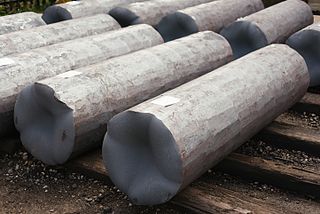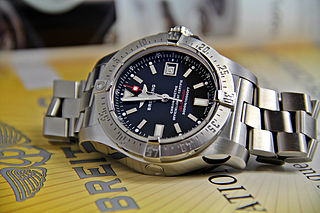Related Research Articles

Stainless steel, also known as inox, corrosion-resistant steel (CRES), and rustless steel, is an alloy of iron that is resistant to rusting and corrosion. It contains iron with chromium and other elements such as molybdenum, carbon, nickel and nitrogen depending on its specific use and cost. Stainless steel's resistance to corrosion results from the 10.5%, or more, chromium content which forms a passive film that can protect the material and self-heal in the presence of oxygen.
Surgical stainless steel is a grade of stainless steel used in biomedical applications. The most common "surgical steels" are austenitic SAE 316 stainless and martensitic SAE 440, SAE 420, and 17-4 stainless steels. There is no formal definition on what constitutes a "surgical stainless steel", so product manufacturers and distributors often apply the term to refer to any grade of corrosion resistant steel.

Monel is a group of alloys of nickel and copper, with small amounts of iron, manganese, carbon, and silicon. Monel is not a cupronickel alloy because it has less than 60% copper.
In modern Western body piercing, a wide variety of materials are used. Some cannot be autoclaved, and others may induce allergic reactions, or harbour bacteria. Certain countries, such as those belonging to the EU, have legal regulations specifying which materials can be used in new piercings.
AL-6XN is a type of weldable stainless steel that consist of an alloy of nickel (24%), chromium (22%) and molybdenum (6.3%) with other trace elements such as nitrogen.

Titanium alloys are alloys that contain a mixture of titanium and other chemical elements. Such alloys have very high tensile strength and toughness. They are light in weight, have extraordinary corrosion resistance and the ability to withstand extreme temperatures. However, the high cost of processing limits their use to military applications, aircraft, spacecraft, bicycles, medical devices, jewelry, highly stressed components such as connecting rods on expensive sports cars and some premium sports equipment and consumer electronics.

Pitting corrosion, or pitting, is a form of extremely localized corrosion that leads to the random creation of small holes in metal. The driving power for pitting corrosion is the depassivation of a small area, which becomes anodic while an unknown but potentially vast area becomes cathodic, leading to very localized galvanic corrosion. The corrosion penetrates the mass of the metal, with a limited diffusion of ions.
Alloy 20 is an austenitic stainless steel containing less than 50% iron developed for applications involving sulfuric acid. Its corrosion resistance also finds other uses in the chemical, petrochemical, power generation, and plastics industries. Alloy 20 resists pitting and chloride ion corrosion, better than 304 stainless steel and on par with 316L stainless steel. Its copper content protects it from sulfuric acid. Alloy 20 is often chosen to solve stress corrosion cracking problems, which may occur with 316L stainless. Alloy of the same name with the designation "Cb-3" indicates niobium stabilized.
Marine grade stainless alloys typically contain molybdenum to resist the corrosive effects of NaCl or salt in seawater. Concentrations of salt in seawater can vary, and splash zones can cause concentrations to increase dramatically from the spray and evaporation.
The Unified Numbering System for Metals and Alloys (UNS) is an alloy designation system widely accepted in North America. Each UNS number relates to a specific metal or alloy and defines its specific chemical composition, or in some cases a specific mechanical or physical property. A UNS number alone does not constitute a full material specification because it establishes no requirements for material properties, heat treatment, form, or quality.

Austenitic stainless steel is one of the five classes of stainless steel by crystalline structure. Its primary crystalline structure is austenite and it prevents steels from being hardenable by heat treatment and makes them essentially non-magnetic. This structure is achieved by adding enough austenite-stabilizing elements such as nickel, manganese and nitrogen. The Incoloy family of alloys belong to the category of super austenitic stainless steels.

The SAE steel grades system is a standard alloy numbering system for steel grades maintained by SAE International.

A diving watch, also commonly referred to as a diver's or dive watch, is a watch designed for underwater diving that features, as a minimum, a water resistance greater than 1.1 MPa (11 atm), the equivalent of 100 m (330 ft). The typical diver's watch will have a water resistance of around 200 to 300 m, though modern technology allows the creation of diving watches that can go much deeper. A true contemporary diver's watch is in accordance with the ISO 6425 standard, which defines test standards and features for watches suitable for diving with underwater breathing apparatus in depths of 100 m (330 ft) or more. Watches conforming to ISO 6425 are marked with the word DIVER'S to distinguish ISO 6425 conformant diving watches from watches that might not be suitable for actual scuba diving.
Zeron 100 is a super duplex stainless steel developed by Rolled Alloys. The alloy has excellent corrosion resistance combined with high strength. It typically contains 25% chromium and 7% nickel and 3.6% molybdenum along with copper and tungsten additions. Zeron 100 has a 50–50 austenitic–ferritic structure. It also has greater resistance to chloride pitting, crevice corrosion and stress corrosion cracking than exhibited by the standard 300 series stainless steels.
Incoloy refers to a range of superalloys now produced by the Special Metals Corporation (SMC) group of companies and created with a trademark by the Inco company in 1952. Originally Inco protected these alloys by patent. In 2000, the SMC published a 61-page document entitled "High-Performance Alloys for Resistance to Aqueous Corrosion" highlighting Incoloy, as well as Monel and Inconel products, and their use in fluid environments such as sulfuric acid, hydrochloric acid, hydrofluoric acid, phosphoric acid, nitric acid, other acids as well as freshwater environments.
SAF 2205, is a Alleima-owned trademark for a 22Cr duplex (ferritic-austenitic) stainless steel. SAF derives from Sandvik Austenite Ferrite. The nominal chemical composition of SAF 2205 is 22% chromium, 5% nickel, 3.2% molybdenum and other alloying elements such as nitrogen and manganese. The UNS designation for SAF 2205 is S31803/S32205 and the EN steel no. is 1.4462. SAF 2205 or Duplex 2205 is often used as an alternative to expensive 904L stainless steel owing to similar properties but cheaper ingredients. Duplex stainless steel is available in multiple forms like bars, billets, pipes, tubes, sheets, plates and even processed to fittings and flanges.

SAE 304 stainless steel is the most common stainless steel. It is an alloy of iron, carbon, chromium and nickel. It is an austenitic stainless steel, and is therefore not magnetic. It is less electrically and thermally conductive than carbon steel. It has a higher corrosion resistance than regular steel and is widely used because of the ease in which it is formed into various shapes.

SAE 316L grade stainless steel, sometimes referred to as A4 stainless steel or marine grade stainless steel, is the second most common austenitic stainless steel after 304/A2 stainless steel. Its primary alloying constituents after iron, are chromium, nickel (10–12%) and molybdenum (2–3%), up to 2% manganese, with small (<1%) quantities of silicon, phosphorus & sulfur also present. The addition of molybdenum provides greater corrosion resistance than 304, with respect to localized corrosive attack by chlorides and to general corrosion by reducing acids, such as sulfuric acid; while sulfur is added to improve ease-of-tooling/machinability. 316L grade is the low carbon version of 316 stainless steel, which improves relative corrosion-resistance. When cold worked, 316 can produce high yield and tensile strengths similar to Duplex stainless grades.
References
- ↑ "Stainless Steel - Grade 904L (UNS N08904)". AZO Materials. Retrieved 29 August 2024.
- ↑ "Stainless Steel - Grade 316L - Properties, Fabrication and Applications (UNS S31603)". AZO Materials. Retrieved 29 August 2024.
- ↑ "904L Datasheet" (PDF). Atlas Steels.
- ↑ "904L Datasheet" (PDF). Rolled Alloys.
- ↑ "904L Datasheet" (PDF). ATI Metals.
- ↑ "Stainless Steel - Grade 904L (UNS N08904)". AZoM.com. 2001-11-07. Retrieved 2017-06-02.
- ↑ "Stainless Steel 904L Manufacturer, Supplier, Stockist, Exporter". Ritinox Overseas. Retrieved 2017-06-02.
- ↑ "The Seamaster Chronicles - Part 1". monochrome-watches.com. 2018-11-16. Retrieved 2020-12-23.
- ↑ Jahn Karsybaev (9 April 2016), Watches: How to Design, Manufacture and Build a Brand, Lulu.com, p. 48, ISBN 978-1-365-03518-0